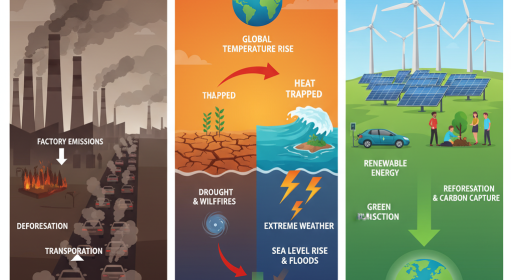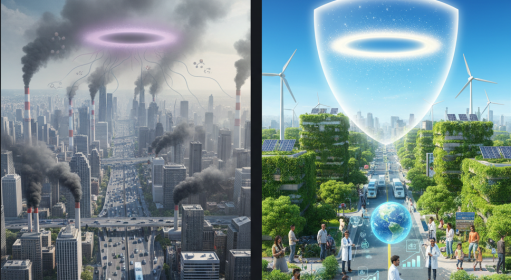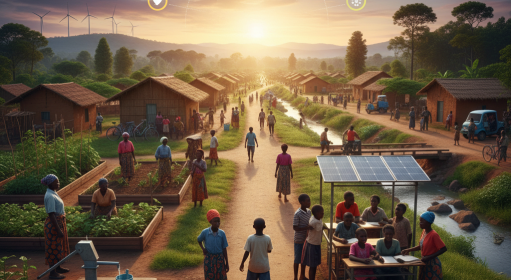If you’ve ever stepped into a greenhouse, you know how warm it feels inside. That’s because the glass traps sunlight and heat, creating a warmer microclimate. Earth’s atmosphere works in a similar way. Certain gases, known as greenhouse gases (GHGs), trap heat from the sun and keep the planet warm enough to sustain life. Without them, Earth would be a frozen wasteland.
But here’s the problem: human activities have dramatically increased GHG concentrations, trapping too much heat and driving global warming. The result? Rising seas, extreme weather, biodiversity loss, and threats to human survival. Understanding GHGs and the greenhouse effect is crucial to solving the climate crisis.
What is the Greenhouse Effect?
The greenhouse effect is a natural process where greenhouse gases trap heat in Earth’s atmosphere. Sunlight enters, warms the planet, and some heat radiates back to space. But instead of escaping, much of it is absorbed and re-emitted by GHGs.
- Natural greenhouse effect: Keeps Earth’s average temperature around 15°C, making life possible.
- Enhanced greenhouse effect: Human activity increases GHG levels, causing more heat to be trapped, leading to global warming.
Major Greenhouse Gases and Their Sources
- Carbon Dioxide (CO₂): From burning fossil fuels, deforestation, and cement production. ~76% of global emissions.
- Methane (CH₄): From agriculture (especially cattle), landfills, and fossil fuel extraction. Over 25 times as potent as CO₂ over 100 years.
- Nitrous Oxide (N₂O): From agricultural fertilizers and industrial processes. Nearly 300 times more potent than CO₂.
- Chlorofluorocarbons (CFCs) & Hydrofluorocarbons (HFCs): Industrial gases with global warming potential thousands of times higher than CO₂.
- Water Vapor: Natural, but amplified by warming, which increases evaporation.
The Impact of Greenhouse Gases on the Planet
- Rising Temperatures: The last decade was the hottest on record.
- Melting Ice & Rising Seas: Threatening coastal cities and island nations.
- Extreme Weather: More powerful hurricanes, droughts, and floods.
- Ecosystem Disruption: Coral bleaching, species loss, and changing migration patterns.
- Human Health Risks: Heatwaves, malnutrition, and spreading diseases.
Country Case Studies: Global Emission Hotspots
- China: The world’s largest emitter (~30% of CO₂), reliant on coal but also the top investor in solar and renewable energy.
- United States: Among the highest per-capita emitters. Transport and industry dominate emissions, though clean energy investments are accelerating.
- India: Emissions rising with economic growth, but also a global leader in solar expansion and the International Solar Alliance.
- Nigeria: Major emissions from gas flaring and deforestation, alongside high vulnerability to climate disasters like floods and desertification.
- European Union: A global model for emission cuts, reducing CO₂ by over 30% since 1990 while pushing renewable energy and a circular economy.
Climate Agreements and Policy Responses
- Paris Agreement (2015): Nearly 200 countries pledged to limit warming to 1.5–2°C with national action plans.
- COP Summits: Annual UN climate talks where global leaders assess progress and negotiate stronger climate commitments.
- Net Zero Pledges: Over 140 nations aim for carbon neutrality between 2050 and 2060. Ambitious but dependent on action.
- Carbon Markets: Trading systems like the EU’s Emissions Trading Scheme encourage industries to cut emissions cost-effectively.
Solutions: Reducing Greenhouse Gas Emissions
- Renewable Energy Transition: Shifting to solar, wind, hydro, and geothermal. Examples: Morocco’s Noor Solar Plant, Kenya’s geothermal power.
- Reforestation & Nature-Based Solutions: Projects like Africa’s Great Green Wall restore ecosystems and absorb CO₂.
- Sustainable Agriculture: Climate-smart farming reduces methane and nitrous oxide while boosting food security.
- Circular Economy: Recycling, reuse, and efficient resource use cut emissions and create green jobs.
- Green Transport: Expanding electric vehicles and public transit, with success stories in Norway (EVs) and Bogotá (bus rapid transit).
- Carbon Capture and Storage (CCS): Capturing CO₂ from industries and storing it underground, offering hope for hard-to-decarbonize sectors.
Everyday Actions: How Individuals Can Help
- Reduce energy waste at home and work.
- Choose sustainable diets and cut food waste.
- Support green transport: walk, cycle, or go electric.
- Plant trees and support reforestation programs.
- Advocate for strong climate policies and accountable leaders.
“The greenhouse effect is natural, but the enhanced greenhouse effect is human-made. If left unchecked, it will reshape Earth’s climate in ways that threaten every species, including ours. The good news? We know the causes, we know the solutions, and we have the tools. What’s needed now is political will, public action, and global solidarity. Together, we can cut emissions, restore ecosystems, and create a future where the greenhouse effect remains a life-giving shield, not a death sentence.“




